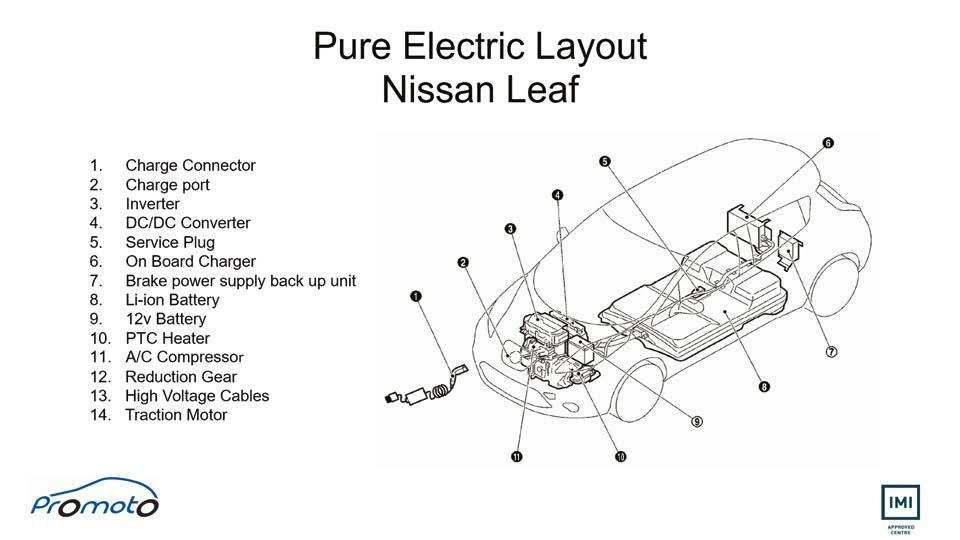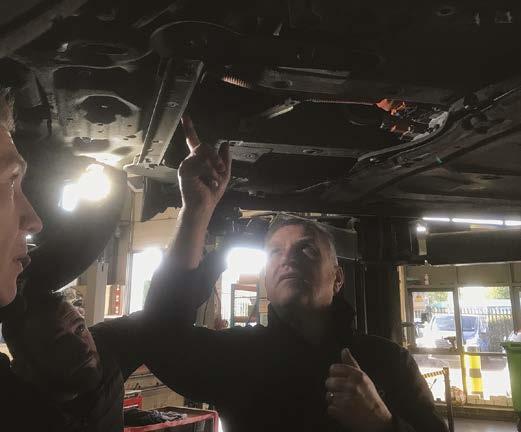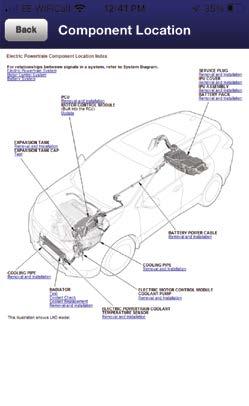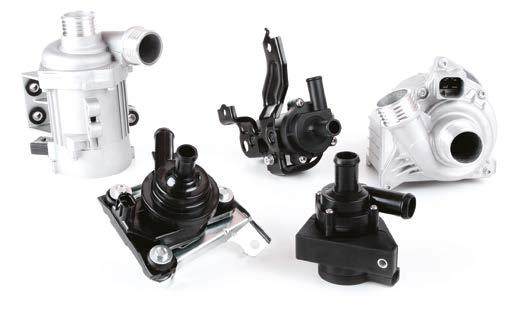
17 minute read
Hybrid & EV repair: Training review products & support
Danger, danger – high voltage!
Sitting on the fence when it comes to EV training was no longer an option for MY Motoring in Gillingham. Editor Nicola St Clair joins them for some on-site training to learn how to safely work on high voltage vehicles.
I have been taking my cars, and recommending my family and friends take theirs, to the independent, family-run workshop down the road for years. Brothers James and Michael Cameron and the team at MY Motoring in Gillingham, Kent have provided a professional, friendly service to customers in the area since 2005 but they recently lost my custom….
Earlier this year, I took the plunge and bought myself a 2017 Nissan Leaf, an investment to reduce my monthly outgoings and eliminate the considerable pollution I was adding to the local environment with my aging, gas-guzzling Saab 9-3. The Leaf is nippy on my local commutes and is as cheap as chips to run – with one home-charge costing around £4. But when it came to getting a major service and MOT last month I took the car to my nearest dealership, not something I have done before, as my trusted workshop down the road had not yet undertaken any hybrid or EV training but they have now rectified this!
As an LKQ Euro Car Parts customer, they tend to use its Auto Education Academy platform for their training, now relaunched as LKQ Academy, and a recent cancellation meant that the team could get booked in for an ‘IMI Level 2 Award in Hybrid Electric Vehicle Routine Maintenance Activities’ at short notice. So, I wrapped up warm and joined MY technicians Hassan Khreibani, Adam Tebbutt and Andrew Rowley at the local workshop for the on-site training. Pro-Moto Trainer Rob Usherwood delivered the day’s training on behalf of LKQ Academy, using his Toyota Prius, and my Nissan Leaf for comparison, during the practical tasks.
7 steps to make a hybrid or electric vehicle safe to work on:

1. Duty of care to others: Ensure suitable signage is placed on the vehicle and restrict access prior to any work/tasks carried out on the High Voltage system
2. Switch ignition off & place keys at least 3 metres away
3. Disconnect negative terminal from conventional 12-volt battery
4. Wear correct PPE
5. Remove service connector/Switch main contactor off
6. Wait 5 minutes
7. Check for voltages at HV Terminals.
The content of the IMI Level 2 Award qualification has been designed to give technicians the knowledge and skills required to work safely on Electric/Hybrid vehicles whilst carrying out routine maintenance and repair activities. The Level 3 and 4 Award that follow equip you with the know-how to diagnose and repair the high voltage components and systems themselves. For the morning’s theory session, Rob detailed the terminology, types of Hybrid & EV vehicle layouts and the arrangement of high voltage systems before we headed over to the Prius to identify the various components and considerations when performing maintenance tasks. Understandably, we then spent much of the time going through the 7-step safety precautions and procedures, with each technician performing the practical task of shutting the car down, proving it is safe and re-instating. A technical writeup on this process was performed as part of their assessment. Rob then provided details of the first aid required for the various potential hazards and gave an overview of Auto-Stop Systems and the construction and function of Hybrid/EV systems.

“We feel this course will be hugely beneficial to us and our customers to keep up to date with the demand of electric and hybrid vehicles. We know the amount of these vehicles on the road will continue to rise over the next few years and we want stay ahead of the game and to be able to provide the services our customers need.” Michael Cameron, MY Motoring

LKQ Academy can provide on-site training at your workshop
The final part of the afternoon session saw the technicians complete an online assessment, to ensure they had learnt the essential steps to ensure safe working around these high voltage systems. I am happy to say all three technicians passed with flying colours and are eager to complete the next levels of accreditation.
Thank you to LKQ Academy for supplying the training, Rob Usherwood and Pro-Moto for the perfect delivery, and to the fantastic team at MY Motoring for their eagerness to keep up with technology.
Investing in becoming Hybrid & EV ready
There is a perception that becoming electric vehicle and hybrid-ready is a big financial commitment, but LKQ Euro Car Parts says that training and equipping your garage can cost less than you think and because specialist hybrid and EV servicing commands a high labour rate, a return on this investment can be realised quickly.
Approximately 6% of technicians in the UK are currently trained to support a market of more than 750,000 hybrid and pure EVs, so there’s a real opportunity for technicians who upskill now to set themselves apart from the competition. Hybrids are already fairly common in the independent aftermarket, with many in their fourth and fifth years of ownership. And EVs won’t be far behind.
Signing up for the LKQ Academy is free, and annual memberships start from £549 + VAT. With more than 30 locations in the UK and Ireland, LKQ Academy offers Level 2,3 and 4 hybrid & EV repair training courses, all backed by the IMI’s “Tech Safe” scheme.
The Level 2 course is the most popular, and covers routine maintenance activities and terminology, while providing technicians with a thorough understanding of the construction and function of hybrid-electric systems and outlining key safety considerations for working with high-voltage operations and components.
Level 3 builds on this to cover system repair and replacement, as well as more advanced electrical regeneration, rectification, and regulation skills. And for those that want to continue their training, the Level 4 course extends further into diagnostics, testing and advanced repairs.
The 2022 course schedule is open for bookings at www. lkqacademy.co.uk. Membership fees can be paid as a one off or as a 12-month direct debit. For more info, email training@eurocarparts.com.

The Society of Motor Manufacturers and Traders’ September 2021 report showed sales increases of 104.9% and 87.9% (year-to-date change) for new plug-in hybrid electric and battery electric vehicles respectively and workshops are catching up with this trend, with training courses enabling technicians to safely work on these vehicles proving popular, with many dates fully booked months in advance. However, current estimates still highlight around only 6% of the workforce are EV qualified.
A YouGov study of 1,731 UK drivers commissioned by The Motor Ombudsman reveals that six in ten respondents would consider getting behind the wheel of an electric car if they were to purchase a new or used vehicle in 2022, with 39% of citing the fact that a decision to go electric was due to the rising cost of fuel. MD Bill Fennell, comments: “As our study has shown, electric vehicles are fast becoming a leading choice for motorists when buying a car, thanks in part to the growing charging network and the greater choice of models now on the market. However, current events, such as the rising cost of petrol and diesel at the pumps, the unavailability of fuel, as well as the expansion of the Ultra-Low Emission Zone in the London area, are clearly front of mind for consumers, and are playing their part in the decision regarding what type of car to get next.”
Over the next few pages, we look at the latest offerings from parts and training suppliers to support the growing opportunity that hybrid and EV repair presents…

Parts for an EV can differ to their ICE cousins
Be wary of ‘identical’ ICE and EV components
Peter Wallace, Comline Auto Parts’ Group Senior Business Line/Product Manager, tells autotechnician that technicians need to be cautious when fitting EV steering & suspension components. While developing its steering & suspension catalogue, Peter has noticed scenarios where parts for an EV are different to their internal combustion engine cousins; for example, on an electric Peugeot 208 and Vauxhall Corsa-F, the original anti-roll bar link is lighter than the one fitted to models with an ICE. Peter explained: “My gut instinct is that these parts have been made lighter to compensate for the additional battery weight. The issue, though, is that these components will look identical to the original specification but will comprise of subtle rotational or dimensional differences; therefore, if fitted, those components will cause some issues when the vehicle is being driven, such as veering left-to-right (yaw ratio) and vice-versa.
"What's more, sticking with the same vehicle layout, the orientation of the bush in the lower wishbone arms are different on the electric version, which will allow for similar comfort as the ICE version when going over bumps – again, due to weight. The same applies to the ball joint, which has a different articulation angle and mounting face to pinch bolt height. These are things that technicians need to be aware of and why Comline’s cataloguing needs to be accurate and upto-date.”
Peter believes this trend is a result of VMs changing their approach when developing parts for their vehicles. “When the Nissan Leaf (2010-2017) was launched, it was equipped with components from models within Nissan’s existing range, such as arms, links, ball joints and track rod ends off a Nissan Juke (2010-onwards); however, because of scenarios like the one identified above, VMs are having to change tact.
“The Tesla Model 3, Audi e-tron and Volkswagen ID.3 are all examples where every part is new, so VMs are spending significant amounts of time and resources in developing new parts. As a result, technicians need to be careful and may need to adapt their fitting techniques because it’s not just ‘another vehicle’; it’s a heavier vehicle and boasts different characteristics, wear and tear.”
Comline is set to launch 50 parts that will only fit EV vehicles over the next three-to-six months. www.comline.uk.com/ products/steering-suspension.
High-voltage e-learning course
The MEYLE Academy has a wide range of free to access digital training courses, including an e-learning course on high-voltage vehicles.
Participants receive a certificate after successful participation and passing of the final exam. This certificate is based on the German DGUV regulations and is mandatory there to work on high-voltage vehicles. MEYLE’s senior technical trainer Patrick Stüdemann stresses the relevance of the course for the international market: “The course content is not only highly relevant for all workshops in Germany but also across the globe, since the training covers all essential aspects, when dealing with a high-voltage vehicle.”
In addition to the relevant safety and health aspects, content includes the differences between the various drive topologies, legal matters as well as hazards and relevant first aid. www.meyle.com/en/trainings
Instant access to vital data

Pro-Assist is a mobile app, designed by training providers ProMoto, providing access to critical and simplified information for technicians working on hybrid and electric vehicles.
Vehicle manufacturers all have a different way of presenting the relevant and critical information, Pro-Assist presents the different Hybrid, Electric, REV models currently across the UK and European markets in one intuitive format. Users can find the technical information required to correctly, and safely, work on these vehicles – from towing to safe shut-down procedures.
Download the app on the Apple Store or Google Play via https://m.appbuild.io/proassis
A new era for the electric motor
Remanufacturer Carwood is evolving its offering to include capability for hybrid & electric vehicles. Here, they tell autotechnician about its upcoming specialist rewind business based down in Yeovil, that enables workshops to provide customers with a cost-effective electric motor repair
Although electric motors have been used in automotive applications for well over a century, their adoption as one of the three main powertrain components in electric vehicles, effectively replacing the internal combustion engine, represents a significant technology leap. Whilst traditional motors typically consist of a stator, rotor and bearings, the latest generation of motors for electric vehicles are much more complex. Incorporating integrated gearboxes, sophisticated electronic control and hi-tech cooling systems, they are a completely different animal, and require an altogether different skill set to service them.
Faced with this reality, many garages shy away from any sort of work on the electric motor in hybrid and electric vehicles, choosing only to sell the motor, and not offer even a fitment service, let alone repair. As well as the unnecessary expense of a brand-new motor, this costs the vehicle owner additional time and hassle. Carwood has the necessary equipment and know-how needed to return the unit to its original condition, providing hybrid and EV owners with a much more costeffective and convenient service option.
The company recently had a Renault Zoe come into its Coventry workshop, with a danger warning sign illuminated on the dashboard, indicating a high-voltage, electrical fault and rendering the vehicle undriveable. Having performed a series of advanced, on-vehicle diagnostic tests, and the prospect of a new replacement unit costing the customer upwards of £2,000, the motor was removed and sent to Yeovil for further testing. Here, the motor was stripped down and subjected to further diagnostic and test routines, developed in-house for the remanufacturing of electric vehicle motors. Although the motor was intended to be non-serviceable, Carwood has also developed special tools to both dismantle, and reassemble the motor assembly back to OE build specifications.

An EV motor stator
A stator fault, caused by an insulation failure on one of the slot linings, was subsequently identified, requiring a full rewind – an intricate process which took over 16 hours to complete by hand. To verify its electrical integrity, and confirm the fault had been fixed, the stator was retested on a static surge test. Once reassembled with new bearings, seals and brushes, the complete motor was then put on a dynamometer to replicate on-vehicle conditions, before being reinstalled into the customer’s car. With a motor now performing as good as new, and with a much lower bill, the customers were very satisfied.
Carwood’s electric motor programme for hybrid and electric motors will be launched in early 2022.
Email: electricvehicle@carwood.org
Causes of electric motor failure
Carwood is seeing electric motor failures due to a variety of reasons. These include:
• Contamination from chemicals, dirt, dust, and moisture leading to premature winding and bearing failures
• Overheating due to failures in external cooling systems fitted to the vehicle, i.e., HVAC or water pump plus radiator, depending on the configuration
• Electrical erosion, also known as electric arcing, caused when a stray current uses a bearing as its path to ground
• Vibration due to poor alignment or unbalance, creating unnecessary force/strain on the bearing
• Inadequate isolation between the motor windings or conductors causing short circuits and leakages, and eventually, motor failure
• Electrical overload if the flow of current through the motor windings exceeds the safe amount - this can be caused by low voltage, requiring the motor to draw excess current to maintain torque, excessive voltage, or short-circuited conductors.
Evolving support
Tapping into new trends, and preparing for them in advance, is essential for the long-term success of a workshop says Schaeffler, and it is working on solutions to support workshops moving forward. “We consider digitalisation to be an opportunity to support complex repair procedures onsite,” explains Jens Schüler, President GKAM, Global Sales & Marketing. REPXPERT provides workshops with appropriate special tools and repair support, not just via traditional channels like personal training and hotlines, but increasingly through digital formats such as virtual installation instructions and training sessions.
Schaeffler is also helping to ensure that independent workshops do not lose out on the opportunities offered by electric mobility, developing e-axles and hybrid modules for electric vehicle manufacturers.
Evolving components
The impact of new technologies on the independent aftermarket (IAM) has had a big influence on the direction Nissens Automotive has taken. “We see two main technology impacts on the IAM currently – new e nergy vehicles (NEVs) and electrification of components,” says Nissens VP of Product & Technology, Jesper Petersen.
“We already have plans to be part of the development and preparation for upcoming NEVs. For electrification of components, emission norms and rigorous efficiency standards are forcing car manufacturers to provide vehicle systems with more intelligent parts. We must address this change as many components in the Nissens portfolio are currently experiencing an update, for example, our electrically actuated turbochargers, EGR valves, electric water pumps and electronically controlled fan/ blower assemblies.”
The company is now focusing on more active parts in its offerings across three major systems – air conditioning (AC), engine cooling (EC) and efficiency & emissions (EE) – by developing electricity-driven and software-controlled components. It currently provides almost 400 parts for the most popular hybrid and electric cars, for systems like AC, including heat pumps and compressors, as well as parts for the EC and EE systems, like EGR valves and turbo part upgrades.

Nissens' electrical water pump - there will be more instances of cooling and HVAC systems where electrical components supersede traditionally powered components
EV Masters Roadshow
Our Virtual Academy has entered the world of face-to-face training and the first offering of OVA Live is its EV Masters Roadshow, developed in partnership with HEVRA.
Over four days, technicians will be fully immersed in the practical diagnosis of hybrid and electric vehicles, giving successful candidates an IMI Level 4 Award and the necessary skills, knowledge, and confidence to undertake the diagnosis and associated repairs of electrified vehicles The time spent in the classroom will be kept to a minimum, with a heavy emphasis on immersive, practical training on real cars with live faults, within the workshop.
The training includes the function, operation and diagnosis of the following systems: Hybrid/Electric Vehicle Powertrain Management – Sensors, Actuators, and Control Methods; Charging Systems – Cables, Connections, Communication Protocols; Battery Management Systems – Operating States, Failure Modes, Monitoring Systems, Thermal Management; Battery Diagnosis and Repair – Live Work and Analysis; Hybrid/ Electric Vehicle Safety and Protection Systems – Interlock, Isolation, Insulation, and Bonding Circuits.
The course is being held at multiple locations across the UK – upcoming dates include Walsall 14-17 December, St. Helens 18-21 January 2022, Somerset 25-28 January, Surrey 15-18 February, and Brands Hatch 22-25 February. Candidates must already have achieved the Level 3 Award in Electric Hybrid Vehicle System Repair and Replacement, or an equivalent industry qualification.
“This incorporates IMI Level 4, but it’s called EV Masters for a reason,” Ben Stockton, MD of Our Virtual Academy told autotechnician. “We’re very good trainers but we do acknowledge we’re not there working day in, day out at the grindstone seeing all of the various faults that are around and this is where our tie up with HEVRA has come in. Pete Melville has been collecting failed components for a donor vehicle that we can use, simulating genuine faults that have happened and have been diagnosed throughout the HEVRA network. We dedicate around two and a half days teaching the diagnostic techniques and underpinning knowledge of what these techniques are all about and then wheel out the vehicle and go through the hands-on training, giving us the confidence that what we’ve taught them on the hypothetical on how to diagnose, transfers into doing it for real, with real faults.” The four-day EV Masters training costs £1,395 + VAT per person. In addition to receiving an OVA EV Masters certificate and an IMI L4 certificate, attendees will also gain three months free access to the advanced hybrid and electric content on OurVirtualAcademy.com.
Email: Sales@OurVirtualAcademy.com
www.ourvirtualacademy.com/ev-masters-roadshow
EV battery & coolant leak detector
Redline Detection has engineered diagnostic leak detection technology exclusively for battery electric vehicles. “Redline has partnered with leading EV automakers to develop technology that gives 100% assurance that battery cases and battery coolant systems are sealed under precise pressures and meet all OEM and battery manufacturer warranty standards for safety,” says CMO Alex Parker.
The Battery + Coolant Leak Detector (BCLD) was designed to test the integrity of battery enclosures in electric and hybrid vehicles, it connects to the battery enclosure on or off the vehicle, giving audible and visual progress and precise pass/fail indication—specific to that battery and vehicle type—when testing is complete. Data logging and reports can be accessed remotely, and the machine is programmable for future battery configurations.
Testing the integrity of battery enclosures is necessary to ensure that there is no possible intrusion of water, dust, or contaminants that could cause catastrophic failure. Battery enclosures are tested after any collision, even a scrape to the bottom of the battery box over a curb that could compromise the seal, as well as after lid off battery maintenance or service.








